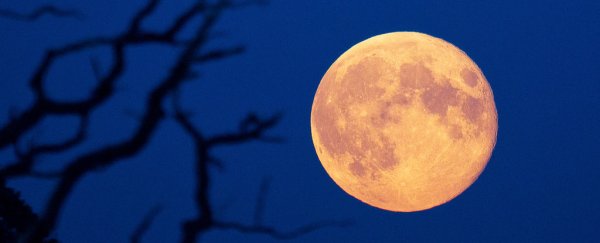Scientists have long debated whether the movements of the Moon and the tidal stresses it generates play a role in triggering earthquakes, and now it looks like we might have an answer.
A new study by researchers in Japan suggests that large earthquakes are more likely to occur at times of a full or new Moon – the two lunar phases when tidal stresses on Earth are at their greatest.
Scientists from the University of Tokyo analysed three separate seismic databases – global data, plus records for California and Japan – looking at large earthquakes (with a magnitude 5.5 or greater) that occurred in the past two decades.
Focusing on the fortnight in the lead-up to these earthquakes, the team reconstructed the size – or amplitude – of tidal stresses at each point in time, and found that the largest quakes most often occurred on days near new or full Moons.
At these two points during the monthly lunar cycle, the Sun, Moon, and Earth all align, and the gravitational tug of the Moon on Earth is at its most intense.
Scientists have long speculated that this alignment could hypothetically influence earthquakes – due to a stronger-than-usual pull being exerted on fault-lines – and the Tokyo researchers' findings now suggests that's likely the case.
Some of the most powerful quakes in the past 20 years – including Sumatra, Indonesia in 2004 (magnitude 9.3); Maule, Chile in 2010 (8.8); and Tohoku-oki, Japan in 2011 (9.0) – coincided with high tidal stress.
All up, nine of the 12 largest earthquakes in the studied period – those with a magnitude of 8.2 or above – happened around a new or full Moon.
Interestingly, the team found no clear correlation between small earthquakes and tidal stresses, although the data does suggest that the proportion of large earthquakes (compared to small earthquakes) increases as tidal stresses become greater.
But US research published in July did find a link between very small tremors (around magnitude 1.0) in the San Andreas Fault and the Moon's position.
That study, led by Nicholas van der Elst from the US Geological Survey, suggested that small earthquakes coincided with the Moon in its waxing phase, building up to a full Moon.
While we don't fully understand what causes major earthquakes to happen, scientists think it could be the result of a cascading process, with a tiny fracture building up into a much larger rupture underground.
Looking at the two studies together, then, it could be possible that tidal stresses due to the Moon are leading to small quakes, which on some occasions may become full-blown monsters.
"This suggests that the probability of a tiny rock failure expanding to a gigantic rupture increases with increasing tidal stress levels," the researchers explain in Nature Geoscience.
"We know from studying rock friction in the laboratory that the fault does not go from locked up to sliding in an instant," van der Elst, who was not involved with the new paper, told Rebecca Boyle at The Atlantic. "It can take hours, days, or even longer for the fault to really come un-glued, even when the stress has exceeded the supposed strength."
But we shouldn't necessarily attribute too much importance to the Moon when it comes to trying to explain earthquakes. After all, the studies so far only establish a correlation – not any evidence of causation.
And the primary causes, van der Elst says, remain processes occurring deep inside Earth's crust, with tectonic plates grinding together until something dramatically snaps.
"The tides just add a little – 1 percent or less – additional push on top of that tectonic loading," van der Elst told Rong-Gong Lin II at The Los Angeles Times.
"Even though it's a small contribution, it could be just the amount of stress that is the 'straw that breaks the camel's back', so to speak."
